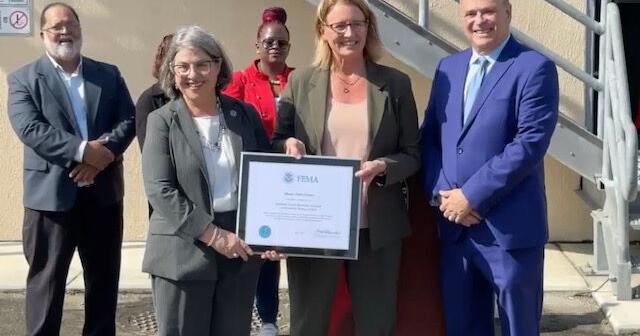Forward-thinking and a billion-dollar investment is beginning to pay off in a big way for some 100,000 Miami-Dade County homeowners, whose flood insurance premiums could begin shrinking by as much as 35%.
The overall savings could amount to an estimated $12 million.
Miami-Dade County Mayor Daniella Levine Cava made the announcement along with other officials Friday morning at the recently created Belen 1 Stormwater Pump Station in West Kendall, adjacent to Tamiami Fire Department Station 58.
“This is very good news,” said Mayor Cava before accepting an honorary certificate from FEMA Administrator Deanne Criswell that shows Miami-Dade as one of just 19 communities across the country that have received a Class 3 designation in the National Flood Insurance Program Community Rating System (CRS).
“Recently, we were at Level 5. We did such a good job (that) we completely jumped a class to get to Level 3,” she said. “The 35% discount is a huge win for our residents and businesses. … I hope it will inspire those who have not yet chosen to take on flood insurance.”
Since joining the national flood rating program 30 years ago, Miami-Dade has invested $1 billion while making a myriad of improvements, including stormwater and septic sewer systems and new and better pump stations like the one serving as the backdrop for Friday’s announcement, to help combat impending sea level rise, more powerful storms and the effects of climate change in general.
Among the changes that have boosted unincorporated Miami-Dade County’s rating have been better flood-warning systems and a call for properties to be built on at least 6 feet of elevation in some designated areas.
Now, Cava has plans to invest another $1 billion for even more resiliency.
“This is a clear example of how investing in climate resilience pays off,” Cava said. “While we build a climate-resilient community that will protect people’s lives and livelihoods now and for the future, we are also providing much-needed relief for thousands of families struggling with rising costs and the direct impacts of climate change.”
The leap to Class 3 puts Miami-Dade County into the upper 2% of all communities nationwide, making it the largest community to be ranked so high.
Cava’s work as the District 8 Commissioner with Cutler Bay followed similar lines, she said.
“I was pleased with the hard work we did there to get (to Class 3). … Coral Gables, Medley and Miami Beach are at Level 5, and I know they can work hard (to improve),” she said.
Criswell was impressed with the tremendous work that has been done and still going on by Cava and her team.
“You really understand the importance of building a resilient community,” she said. “Being prepared can save lives … it will save lives. This is a big deal. … Because of your forward-leaning, historic spending (on these issues), it’s the first time (FEMA’s 34-year program) has raised a community two levels (at once).”
Criswell pointed out that the overall $2 million (additional estimate for a total of $12 million) in savings to unincorporated homeowners with flood insurance goes on top of the already $200 million saved since Miami-Dade joined the program.
“This a big deal, a huge deal, and an example for other communities to invest in,” Criswell said. “You’ve demonstrated that these investments have paid off … These savings can serve as a down payment on the future for all of us.”
The savings to unincorporated Miami-Dade County residents, which go into effect April 1, do not include communities, such as Key Biscayne, which are encouraged to join the national CRS program.
Key Biscayne has been working on several projects and initiatives that have helped or may improve its rating.
“We are working our way to a (Level) 6,” said Dr. Roland Samimy, the Village’s Resiliency and Sustainability Chief. “It’s still a work in progress.”
Keeping residents protected is the primary goal, but every time the CRS rating is lowered, it should translate to dollars saved – although there are specific criteria for the FEMA ratings.
FEMA changed the way it calculates flood insurance prices.
Instead of relying on old flood zone maps covering broad areas, it is now basing premium prices on other factors, like an individual property’s distance from the ocean, rainfall levels and the cost to rebuild a home.
A report last year showed that property owners in the 33149 ZIP code, which includes areas beyond the boundaries of Key Biscayne, will pay the highest premiums in South Florida, an average of $7,000 a year, because of those new calculations.
The pump station behind Cava, she said, is one of 18 in the county, and this one actually was built with 75% of the cost coming from FEMA.
“We’re keeping people safe and saving money,” she said.


































